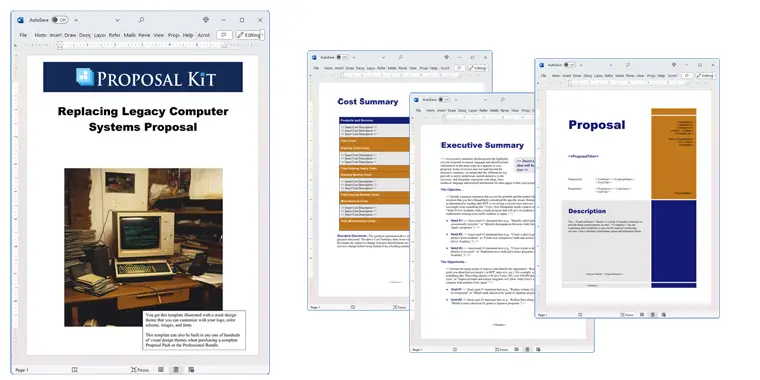How to write your Replacing Legacy Computer Systems Proposal
We include this 20 page layout with every Proposal Pack. If you want this template to have a different visual design theme than the one illustrated here, purchase any Proposal Pack design and create this template using the purchased design theme. This template is included in every Proposal Pack. If you get a Proposal Pack or the Professional, you can also make any variation of this template with different chapters to suit your needs.
We typically include more chapters in the templates than most people will need to give everyone more variety in the chapters they may need. You can trim down a long template by removing pages you do not need or combining multiple chapter topics into one page.
 DOWNLOADABLE, ONE-TIME COST, NO SUBSCRIPTION FEES
DOWNLOADABLE, ONE-TIME COST, NO SUBSCRIPTION FEESYou can also create countless variations of this document to suit your needs using the included library of 2200+ chapters if ordering a Proposal Pack or Professional.
 What Our Clients Say
What Our Clients SayProposal Kit is a game changer when it comes to selling your services in a constructive yet powerful way. The software is easy to use. I highly recommend."
Nextline Protection Services, Inc.
Related Article
Related Video
Related Templates
- Equipment or Machinery Systems Upgrade Proposal
- Server Upgrade and Maintenance Proposal
- IT Equipment Maintenance and Repair Services Proposal
- LAN Upgrade to Wireless Project Proposal
- Software Installation and Training Proposal
- Technology Strategy Analysis
- Software Beta Testing Project Proposal
- Technology Consulting Proposal
- Software System Testing Project Proposal
- Software Automation Proposal
- Software and Hardware System Proposal
- Manufacturing Process Improvement Proposal
- ERP (Enterprise Resource Planning) System Proposal
- Data Center Migration Proposal
What's the best way to write your proposal for replacing legacy computer systems?
Businesses often encounter the challenge of outdated computer systems that no longer receive support from their manufacturers. Creating a proposal to navigate this transformation is crucial, and Proposal Kit offers a proven solution. With its comprehensive template library and intuitive software package, Proposal Kit enables businesses to create proposals for replacing legacy computer systems. This solution not only assists in creating clear and persuasive narratives but also incorporates a line item quoting database system for detailed cost summaries, estimates, and budgets.
Are you facing a similar situation where you must write a proposal for transitioning from obsolete systems to modern solutions? The Proposal Kit is designed to meet your needs.
What Types of Projects Are Replacing Legacy Computer Systems Proposal Written For?
Replacing legacy computer systems can encompass various projects with unique requirements and objectives. These are examples of situations where proposals are created:
- Transitioning from on-premises servers to cloud-based infrastructure
- Migrating outdated CRM systems to modern platforms
- Replacing legacy ERP systems with new, integrated solutions
- Upgrading outdated network hardware and software
- Implementing new data analytics systems in place of outdated ones
- Moving from legacy mainframe systems to distributed architectures
- Replacing old email systems with contemporary communication tools
- Converting paper-based systems to digital solutions
- Updating outdated cybersecurity frameworks
- Moving from legacy billing systems to modern finance solutions
- Implementing new content management systems
- Replacing outdated point-of-sale systems in retail
- Migrating from legacy manufacturing control systems to smart factory solutions
- Updating healthcare information systems in medical facilities
- Moving from legacy telephony systems to VoIP
- Implementing new supply chain management systems
- Replacing outdated learning management systems in educational institutions
- Transitioning from legacy HR systems to modern HRM solutions
- Upgrading outdated customer support systems
- Implementing new mobile application platforms
Chapters this template is built with
Creating a proposal for migrating legacy systems usually requires a custom solution instead of a one-size-fits-all template. Proposal Kit's software allows you to create customized templates to suit various needs, covering all potential topics you may need to address. Here is a starting point with chapter templates from the content library that can be tailored to your specific requirements:
Cover Letter
The Cover Letter sets the stage for your proposal by outlining the purpose and urgency of replacing outdated systems. It serves as your first impression, establishing a connection with the recipient by addressing their specific concerns and briefly introducing the proposed solutions.
Executive Summary
The Executive Summary provides a high-level overview of your proposal, emphasizing the system migration's critical benefits and anticipated outcomes. This section briefly presents the value proposition, highlighting how the new system will enhance productivity, security, and operational efficiency.
Cost Summary
The Cost Summary presents a detailed financial breakdown, including initial costs, ongoing maintenance, and projected savings over time. It should offer clear insights into the budgetary implications and return on investment, helping stakeholders understand the financial rationale behind the migration.
Next Steps
The Next Steps chapter outlines the follow-up actions required after the proposal is accepted. This section ensures all parties understand the immediate actions needed for a smooth transition into the implementation phase, such as contract signing, scheduling kickoff meetings, and allocating initial resources.
Present Situation
The Present Situation section analyzes the legacy systems' current state, emphasizing technical and operational limitations that necessitate the change. It supports the case for migration by detailing issues such as increased downtime, rising maintenance costs, and compatibility problems with newer technologies.
Implementation Plan
The Implementation Plan provides a comprehensive, step-by-step guide to transitioning from old systems to new ones. This chapter details timelines, milestones, resources needed, and contingency plans to address potential risks, ensuring the project stays on schedule and within budget.
Resource Allocation
This chapter details the human, technological, and financial resources required for the migration project's successful execution. It identifies key personnel, outlines necessary training, and specifies technology investments, ensuring all resources are optimally deployed for project success.
Migration
The Migration section elaborates on the transition's technical topics, including data migration strategies, system integration procedures, and risk mitigation plans. This chapter is critical for addressing how existing data and processes will be transferred to the new system without disruption.
Project Management
Project Management discusses the methodologies and tools employed to monitor progress, manage risks, and ensure timely delivery. This section should outline the project management framework, such as Agile or Waterfall, and describe how communication and accountability will be maintained throughout the project.
Impact Statement
The Impact Statement evaluates the anticipated benefits of the migration, such as increased efficiency, reduced operational costs, and improved user satisfaction. It provides quantifiable metrics and success criteria that stakeholders can use to gauge the project's effectiveness post-implementation.
Time Line
The Time Line outlines a detailed schedule for each phase, offering stakeholders a clear view of project duration and key deadlines. This section should include Gantt charts or other visual aids to illustrate task sequence and overlap, ensuring project progression transparency.
Upgrades
This section discusses necessary upgrades to hardware or software to facilitate the new system's operation. It should highlight the improved capabilities and performance benefits these upgrades offer, justifying them as important components of the overall migration strategy.
End of Life
The End of Life chapter addresses the phasing out old systems, including decommissioning plans, data archiving, and user transition strategies. This section is crucial for managing the changeover process and ensuring no critical data or functionality is lost during the switch.
Hardware and Software
This section provides a detailed inventory of proposed new hardware and software solutions, including specifications, performance benefits, and compatibility considerations. It should assess how these components integrate with existing infrastructure to enhance operational capability.
Legacy Systems
The Legacy Systems chapter delves into the specifics of obsolete systems, highlighting their limitations, failures, and risks to the organization. By clearly illustrating these issues, this section helps justify the urgency and necessity of the proposed migration.
Platform
The Platform section discusses the new system's platform, focusing on its scalability, security, and compliance features. This chapter should address how the platform supports future growth, protects sensitive data, and adheres to industry regulations, ensuring it meets current and long-term organizational needs.
Recommendations
In this chapter, you present your professional recommendations, summarizing the best solutions for the system migration. It should reflect a thorough analysis and comparison of options, provide a clear rationale for the chosen approach, and highlight its alignment with the organization's goals.
Use cases for this template
Creating a Persuasive Proposal for ERP System Upgrade
The Challenge
John, a project manager at InnovateIT Solutions, was tasked with persuading a potential client, Tech Solutions Co., to overhaul their outdated Enterprise Resource Planning (ERP) system. This legacy system was plagued by inefficiencies that affected day-to-day operations, causing significant delays and operational cost overruns. For Tech Solutions Co., the decision was not just a technological upgrade but a move to enhance productivity and competitiveness.
The Solution
Facing this challenge, John turned to Proposal Kit for its expansive library of templates explicitly designed for such complex proposals. He selected and tailored templates like the Implementation Plan, which laid out a clear path for system transition, and the Impact Statement, which projected the positive changes expected post-implementation. These templates helped him articulate the tangible benefits and return on investment that Tech Solutions Co. could expect from upgrading its ERP system.
The Implementation
John created a proposal with the Proposal Kit that addressed technical specifics and communicated the move's advantages and financial prudence. The proposal's detailed Time Line offered a realistic schedule for the transition phases, while the Cost Summary provided a clear breakdown of the financial investment required. These topics combined to create a proposal that was as comprehensive as it was compelling, giving Tech Solutions Co. a clear view of the project's scope and potential.
The Outcome
John's proposal's professionalism and clarity resonated with Tech Solutions Co.'s decision-makers, leading to a successful contract award for InnovateIT Solutions. The client was reassured by the well-structured plan and the anticipated positive impact on their operations. As a result, Tech Solutions Co. embarked on an ERP upgrade that promised to streamline their processes and reduce long-term costs, setting them on a path to greater efficiency and growth.
Meeting Tight Deadlines with AI-Assisted Proposal Writing
The Challenge
Lisa, an IT specialist at Greenfield Enterprises, found herself under pressure. The company urgently required a proposal to replace its legacy billing system, and she had just one week to deliver a comprehensive document. The outdated system, which needed to meet the business's demands, led to billing errors and customer dissatisfaction. Lisa needed a solution to expedite the proposal writing process without sacrificing quality.
The Solution
Using the combined power of Proposal Kit and an AI writing tool, Lisa embarked on her task with a plan. Using the AI tool to scan and analyze Greenfield's website content, she generated insightful data for the Present Situation and created informed Recommendations. Proposal Kit's templates provided a solid framework, allowing her to focus on content rather than format.
The Implementation
Lisa worked diligently, customizing the Proposal Kit templates to fit the specific needs of her proposal. She concentrated on the Resource Allocation and Migration sections, ensuring that every detail was accurate and aligned with Greenfield's operational objectives. The AI tool assisted in refining the document, enhancing the narrative with precise language and compelling data points.
The Outcome
Lisa successfully met her deadline with Proposal Kit and AI assistance, delivering a comprehensive and persuasive proposal. Her superiors praised her for the thoroughness and professionalism of the document. The proposal was approved, securing the much-needed billing system upgrade that promised to enhance accuracy, efficiency, and customer satisfaction, thus contributing to the company's continued success.
Issuing a Compelling RFP for Donor Management System Upgrade
The Challenge
Mark, a director at FuturePath, a non-profit organization dedicated to future innovation, was tasked with an important responsibility: issuing a Request for Proposal (RFP) to replace their outdated donor management system. The existing system needed more support and posed significant risks to data integrity, threatening the organization's ability to engage with its donors.
The Solution
Understanding the critical nature of this upgrade, Mark turned to Proposal Kit to develop a clear and structured RFP. He used the Executive Summary template to briefly outline the project's goals and the Legacy Systems template to detail the current system's limitations and the urgent need for change. This approach ensured potential vendors could quickly grasp the project's scope and requirements.
The Implementation
Mark paid meticulous attention to every section of the RFP, ensuring clarity and precision in communicating FuturePath's expectations. By focusing on the requirements for a robust new donor management system, he gave potential vendors a detailed understanding of what the organization needed. The well-written RFP allowed vendors to tailor their responses to meet FuturePath's specific challenges and goals.
The Outcome
Mark's RFP attracted a wide range of competitive bids from vendors. FuturePath evaluated each proposal thoroughly and selected a vendor that offered the most viable and cost-effective solution. The new donor management system promised to significantly enhance donor engagement, improve data security, and streamline operations, enabling FuturePath to continue its mission with renewed vigor and confidence.
Conclusions and Recommendations
Navigating the complexities of writing a proposal for updating obsolete computer systems can be challenging, but using Proposal Kit provides a structured and efficient path to success. Whether you pitch to external clients or internal stakeholders, Proposal Kit offers the tools to create a persuasive and thorough proposal for transitioning from outdated systems to modern solutions.
Also Known As
This template may also be referred to in different ways or be used in more specialized situations, such as:
- Legacy System Transition Proposal
- Obsolete System Replacement Proposal
- IT System Upgrade Proposal
- System Migration Proposal
- Platform Modernization Proposal
- Outdated Software Replacement Proposal
- Enterprise Resource Planning Upgrade Proposal
- Hardware and Software Update Proposal
- Mainframe System Replacement Proposal
- Digital Transformation Proposal
Abstract
 Many organizations struggle with outdated technology and legacy software that impede their daily operations. These legacy systems often come with high maintenance costs, significant downtime, and security vulnerabilities. Modernizing these systems with new technologies can offer various benefits, such as cost savings, improved security patches, and access to advanced features that align with current technological standards.
Many organizations struggle with outdated technology and legacy software that impede their daily operations. These legacy systems often come with high maintenance costs, significant downtime, and security vulnerabilities. Modernizing these systems with new technologies can offer various benefits, such as cost savings, improved security patches, and access to advanced features that align with current technological standards.
By replacing legacy applications with modern systems, businesses can streamline their business processes and eliminate compatibility issues. This transformation project requires a service provider with a proven track record and knowledge of both legacy programming languages and modern technologies. An agile approach to modernization can address technical debt and reduce time-consuming tasks associated with outdated technologies.
For example, government agencies like the National Health Service have faced significant challenges due to reliance on legacy systems for managing electronic health records. By adopting modern systems, they improved access to patient information and reduced disruptions in daily operations. Similarly, the Department of Veterans Affairs initiated a modernization effort to update their operating system and legacy applications, resulting in a huge success in handling patient records.
 Identifying business needs and evaluating hidden costs associated with maintaining outdated technology are essential steps in this process. Modernizing legacy systems not only enhances efficiency and security but also provides a competitive edge in today's fast-paced technological landscape. Organizations can transform their operations, eliminate reliance on incompatible technologies, and achieve significant cost savings by investing in modern systems.
Identifying business needs and evaluating hidden costs associated with maintaining outdated technology are essential steps in this process. Modernizing legacy systems not only enhances efficiency and security but also provides a competitive edge in today's fast-paced technological landscape. Organizations can transform their operations, eliminate reliance on incompatible technologies, and achieve significant cost savings by investing in modern systems.
This shift leads to a more flexible and scalable environment, allowing companies to adapt to new technologies and meet future challenges. Modernization efforts are crucial for organizations seeking to improve performance, security, and overall effectiveness in delivering services.
Frequently Asked Questions
How do I begin writing a legacy computer systems proposal?
Starting a legacy computer systems proposal involves understanding the current issues faced by outdated systems. Begin by gathering detailed information about the existing infrastructure, its challenges, and the objectives of the system upgrade. Using Proposal Kit can significantly simplify this initial phase, providing structured templates that guide you through documenting these critical topics, ensuring that your proposal conveys the necessity for system modernization.
What are the key components to include in a legacy computer systems proposal?
A legacy computer systems proposal should encompass several key components, including an Executive Summary, Present Situation Analysis, Implementation Plan, and Cost Summary. Each section creates a well-rounded argument for why the legacy system must be updated. Proposal Kit offers a comprehensive library of template chapters explicitly tailored for such proposals, ensuring you cover all necessary topics professionally and coherently.
How can I justify the costs involved in legacy computer systems?
Justifying the costs in a legacy computer systems proposal involves outlining both short-term expenses and long-term savings. Highlight the inefficiencies and risks associated with the current systems, such as maintenance costs and potential data breaches, compared to the benefits of upgraded systems. Proposal Kit's line item quoting database system is particularly beneficial here, as it helps you create detailed cost breakdowns that demonstrate the financial sense of the proposed upgrades.
How do I address potential risks and challenges in a legacy computer systems proposal?
When writing a legacy computer systems proposal, it's crucial to acknowledge potential risks, such as data migration issues or system downtime, and propose viable mitigation strategies. This transparency builds trust with stakeholders. Proposal Kit offers specific templates to outline these risks and corresponding management plans, ensuring that your proposal provides a comprehensive view of how challenges will be addressed.
How can I tailor my legacy computer systems proposal to different audiences?
Tailoring your legacy computer systems proposal to different audiences involves focusing on relevant topics for each stakeholder group. For technical teams, emphasize the specifics of the new system architecture, while for executives, focus on benefits and ROI. Proposal Kit allows for high customization of content, enabling you to adjust the emphasis and language of your proposal to match the interests and expertise of varied audiences, thereby enhancing its persuasive power.
20% Off Discount
![]() Add To Cart This Word Template
Add To Cart This Word Template
 Add To Cart Proposal Pack for Any Business
Add To Cart Proposal Pack for Any Business
 Add To Cart Proposal Kit Professional
Add To Cart Proposal Kit Professional
 4.7 stars, based on 849 reviews
4.7 stars, based on 849 reviewsProposal Kit chapters used in this template
Cover Letter, Title Page, Table of Contents, Executive Summary, Present Situation, Legacy Systems, End of Life, Migration, Impact Statement, Platform, Hardware and Software, Resource Allocation, Upgrades, Time Line, Project Management, Implementation Plan, Cost Summary, Recommendations, Next Steps, Back Page
Line Item Automated Chapters
If you purchase a Proposal Pack or the Professional Bundle, these proposal pages are generated using an automated line-item database in the included Wizard software.
Cost Summary, Implementation Plan, Time Line
You use this proposal for
- General business proposal
- Technical proposal
- Project pitch proposal
- Internal company proposal
- IT, software, hardware proposal
How to create this template with Proposal Pack Wizard
You can create this document using any of the logo-designed Proposal Packs. Pick any Proposal Pack with a logo design theme you like best; they will all work equally well. The Proposal Pack for Any Business is the pack with no extra added logos or colors - designed to be used plain or for you to customize with your logos and graphics.
The Proposal Pack design theme you purchase will determine the visual look of this template. The screenshot above only shows the plain generic design theme.
We include a library of chapters to be assembled based on your needs. All proposals are different and have different needs and goals. We designed Proposal Pack so you can customize the documents to suit your needs.
You will best create this document using the Proposal Pack Wizard - Expert Edition software to select this template and build it in the Proposal Pack logo design theme of your choice along with any desired customizations (such as adding additional chapters, removing unneeded chapters, changing the order of chapters, and importing your company logo). This template outlines a proposal for the described situation. Each user is responsible for typing in the actual content of the provided pages with their information to complete the proposal. Suggestions in the abstract may include features in higher-end packages and are facilitated by the selection of chapter templates to support the narrative of each proposal, which help guide the user in filling in the details.
The Wizard software's AI Writer will write the content of the pages of the template based on details provided for your company, client, project, financial details and other writing instructions. This will provide a personalized version of the template completely written and ready to edit.
Once finished, the AI Writer's Word-to-PowerPoint converter can transform your proposal, business plan, or other business documents into a PowerPoint slideshow. Save time and effort by letting the AI analyze every chapter to condense its content into talking points, visually matching the document, and providing a consistent package of presentation material with the click of a button.
You create this template using the Wizard software with an entire Proposal Pack library and software. We include the Expert Edition of the software in the Proposal Kit Professional. Microsoft Word for Windows is required to use the customizing software. You can also edit Word document templates in other office software such as Word for Mac. We will assist Mac users in assembling complex templates for their first project if they do not have the required platform to run the Wizard software.
How to Build Templates Featured on Proposal Kit Website
Many people find the Proposal Kit website after searching for a specific proposal. Once you've purchased and installed the software, how do you build that template you found in the first place? This video shows you how to build any proposal you see on the Proposal Kit website.
 Ian Lauder has been helping businesses write their proposals and contracts for two decades. Ian is the owner and founder of Proposal Kit, one of the original sources of business proposal and contract software products started in 1997.
Ian Lauder has been helping businesses write their proposals and contracts for two decades. Ian is the owner and founder of Proposal Kit, one of the original sources of business proposal and contract software products started in 1997.By Ian Lauder
 Published by Proposal Kit, Inc.
Published by Proposal Kit, Inc.


 Cart
Cart
 Get 20% off ordering today:
Get 20% off ordering today: 


 Facebook
Facebook YouTube
YouTube Bluesky
Bluesky Search Site
Search Site